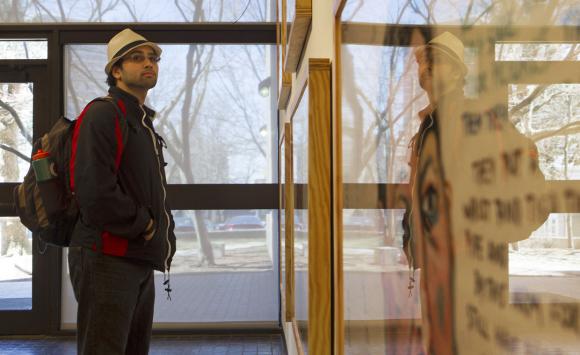Jacob Ramos’s class day starts the way you might expect for someone preparing for medical school: with a physiology class. But that’s about where his schedule ceases to be predictable.
“I’m also taking ‘Contemporary Photography,’ a seminar on Velazquez and Spanish art in the 1600s, and my last class is ‘Imagining Nation and Empire in the 19th Century’,” Ramos said.
The third-year student is part of Brown’s Program in Liberal Medical Education, an eight-year program that combines undergraduate work with professional study at Brown’s Warren Alpert Medical School. The program is designed to be an application of Brown’s open curriculum, allowing students to choose any concentration on campus while preparing for their formal medical education.
For Ramos, PLME and the open curriculum were a way to meld his interests. As he prepares for medical school, he’s concentrating in art history.
“I really do love my bio requirements and all those chemistry classes too,” he said. “But I knew I was going to end up spending a lot of time on the liberal arts side of things. I would either be making art, studying art, writing, or comparing literature. I knew I’d be using that part of Brown.”
It turns out that an atypical class schedule like Ramos has is fairly typical at Brown, according to data gathered by the Committee on Reimagining the Brown Campus and Community. In order to inform decisions about how the Brown campus should grow, the committee carefully analyzed undergraduate course selections. They found that throughout all four years of their undergraduate work, Brown students routinely bounce from discipline to discipline and department to department.
But even without the benefit of hard data, Ramos had a pretty good sense that his peers were also taking advantage of the open curriculum.
“I had a friend who was in religious studies, public health, and pre-med — and he was a varsity athlete,” Ramos said. “He just felt like there was no reason not to take everything that he wanted to take. That’s very much the way Brown students approach this. We don’t just search one department and say, ‘What are the classes here?’ We go through all the departments and see what’s there.”
And even if that means a brisk hike from physiology in MacMillan to photography in List, Ramos doesn’t seem to mind. Ultimately, he says, his art history concentration will inform the kind of doctor he wants to be.
“For me, I really revel in the concept that when you’re examining a historical period or when you’re examining a specific piece of work for its formal qualities, you’re not doing something that’s so different from looking at the medical history of a patient or examining symptoms,” he says. “When I’m having discussions with other art historians, I think that is the structure of dialog that I intend to have with other doctors and colleagues. That’s tied in nicely with what I intend to do in med school.”

